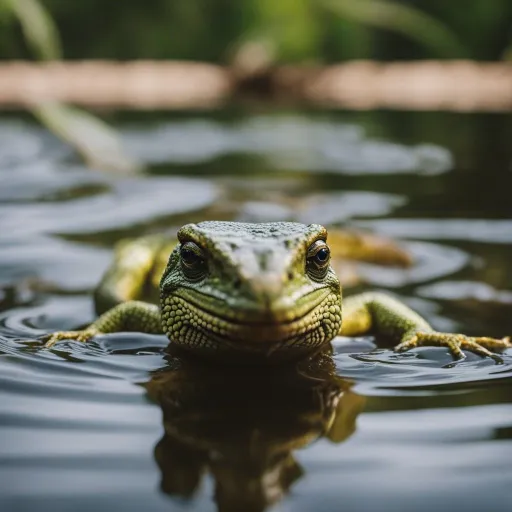
So you’ve found yourself wondering just how big Texas Spiny Lizards can actually get. Well, you’re in luck because this article is here to provide you with all the information you need.
Texas Spiny Lizards, also known as Sceloporus olivaceus, can grow to an impressive size with males reaching up to 9 inches in length, including their tail, and females typically maxing out at around 7 inches.
These fascinating reptiles are native to the southwestern United States, specifically Texas, and have unique physical characteristics that set them apart from other lizard species.
Whether you’re a lizard enthusiast or just curious about the creatures that inhabit the Lone Star State, keep reading to learn more about the impressive size and features of Texas Spiny Lizards.
Physical Description
Overall Size
Texas spiny lizards, also known as Sceloporus olivaceus, can reach a total length of 10 to 12 inches.
This includes their tail, which makes up a significant portion of their overall length.
On average, their snout-to-vent length, which excludes the tail, ranges from 5 to 7 inches.
While not the largest lizards in Texas, they are still impressive in size and have a presence that captures attention.
Body Shape and Structure
These lizards have a robust body structure that is well adapted for their arboreal lifestyle. Their head is somewhat elongated and triangular in shape, with a prominent snout.
Their body is covered in small, granular scales, which give them a spiny appearance, hence their name.
The spines are more prominent along their back and tail, providing extra protection against potential predators.
The tail, in particular, is long and muscular, allowing for balance and quick movement. Overall, their body shape and structure contribute to their agility and ability to climb trees with ease.
Coloration and Patterns
Adult Coloration
Adult Texas spiny lizards display a beautiful array of colors that can vary depending on their geographic location. In general, their dorsal surface is composed of a mix of green, brown, and gray scales. The coloration is often mottled, allowing them to blend into their surroundings and avoid being easily spotted by predators. Their ventral surface, on the other hand, tends to be lighter in color, often a pale cream or white. This contrast in coloration helps to further camouflage them when basking on tree trunks or rocks.
Juvenile and Sub-Adult Coloration
Juvenile Texas spiny lizards have a different coloration compared to adults. They exhibit a more vibrant and distinct pattern that includes a bright blue tail, which gradually fades as they mature.
The coloration of sub-adults is an interesting mix between the vividness of juveniles and the more subdued tones of adults.
This transition in coloration is fascinating to observe and plays a role in the lizard’s ability to adapt to its environment as it grows.
Size Variation
Sexual Dimorphism
There is a noticeable difference in size between male and female Texas spiny lizards, known as sexual dimorphism. Males tend to be larger than females, both in snout-to-vent length and overall size. Adult male lizards can reach a length of up to 12 inches, while females often measure around 8 to 10 inches. This size difference is thought to be related to reproductive strategies and competition for mates.
Geographic Variation
The size of Texas spiny lizards can vary across their geographic range. Lizards in southern Texas tend to be larger compared to those found in northern regions. This variation in size may be influenced by factors such as available food resources, habitat conditions, and even climatic differences. It is essential to consider these variations when studying the biology and ecology of this species in different areas.
Growth and Development
Hatchlings and Young Lizards
When Texas spiny lizards hatch, they are small and vulnerable, measuring only a few inches in length. At this stage, they rely heavily on camouflage and their ability to quickly scurry away from potential threats. As they grow, their body proportions change, and their limbs develop, allowing them to become more adept climbers. During the early stages of their life, their coloration is vibrant and distinctive, providing excellent camouflage among the vegetation.
Rate of Growth
The rate of growth in Texas spiny lizards can vary depending on various factors, including food availability and environmental conditions. Generally, they experience a growth spurt during their first year, increasing in size significantly. As they enter adulthood, the rate of growth slows down, and they reach their maximum size. However, it is important to note that individual lizards may grow at different rates, influenced by genetic factors and the specific conditions in which they live.
Factors Affecting Size
Habitat
The habitat in which Texas spiny lizards reside plays a crucial role in determining their size. Lizards living in more abundant and diverse habitats, such as mixed woodlands or forests, often have access to a more substantial food supply. This allows them to grow larger compared to individuals inhabiting arid or less resource-rich areas. Habitat quality and the availability of suitable microclimates for basking and thermoregulation can greatly influence the overall size of these lizards.
Diet
The diet of Texas spiny lizards consists primarily of small insects and invertebrates. Their food intake, as well as the nutritional value of their prey items, can impact their size. Lizards with access to a varied diet and a higher quantity of food tend to grow more quickly and reach larger sizes. Additionally, the quality and availability of their food source can also affect their overall health and condition, which in turn contributes to their size.
Genetics
Genetic factors undoubtedly play a significant role in determining the size of Texas spiny lizards. Some individuals may have genetic characteristics that promote larger body size, while others may have traits that restrict growth potential. These genetic variations can have both direct and indirect effects on size, as they may influence aspects such as metabolism, growth rate, and even behavior. Studying the genetic makeup of different populations can provide valuable insights into the factors influencing size variation.
Health
The overall health and condition of Texas spiny lizards can impact their size. Lizards that are in good health, free from parasites or diseases, are more likely to reach their full growth potential. Conversely, individuals facing health issues or environmental stressors may experience stunted growth and smaller overall size. Maintaining suitable habitat conditions, offering proper nutrition, and regular veterinary care can help ensure the health and well-being of these lizards.
Predators and Defenses
Predators
Texas spiny lizards are preyed upon by various predators, including snakes, birds of prey, mammals, and even other lizards. Snakes, such as rat snakes and coachwhips, are known to be significant predators of these lizards. Birds of prey, like hawks and owls, have keen eyesight and can quickly spot these lizards as they bask or move across open areas. Mammals, including foxes and raccoons, may opportunistically feed on Texas spiny lizards when the opportunity arises. Interactions with other lizard species, such as fence lizards, may also result in predation.
Defensive Mechanisms
To protect themselves from predation, Texas spiny lizards have developed various defensive mechanisms. When threatened, they can puff up their bodies to appear larger and more intimidating. They may also engage in rapid and erratic movements, making it difficult for predators to capture them. Additionally, their spiny scales serve as a form of armor, deterring potential predators from attempting to consume them. If all else fails, these lizards can resort to dropping their tail as a means of distraction or escape, as the tail will continue to wiggle, diverting attention away from the lizard itself.
Behavior and Habits
Basking
Like many reptiles, Texas spiny lizards rely on basking to regulate their body temperature. They often perch on rocks or tree trunks, positioning themselves to absorb the sun’s rays. Basking not only helps them warm up and reach optimal body temperature, but it also plays a role in their social interactions. Male lizards, in particular, may bask in areas that allow them to display their vibrant coloration, attracting potential mates and asserting their dominance.
Home Range
Texas spiny lizards have relatively small home ranges, often limited to a specific tree or a few neighboring trees. They are primarily arboreal, spending most of their time in trees, and only occasionally coming down to the ground. These lizards have excellent climbing abilities, thanks to their specialized toe pads, which allow them to grip onto rough surfaces. By maintaining a relatively small home range, they are better able to defend resources and increase their chances of successful reproduction.
Activity Levels
These lizards are diurnal, meaning they are most active during the day. They emerge from their shelters in the morning, bask to raise their body temperature, and then forage for food. Their activity levels may vary depending on seasonal and environmental conditions. During hot summer months, they may reduce their activity during the peak heat of the day and be more active in the morning and late afternoon when temperatures are lower. In cooler seasons, they may exhibit reduced activity or even enter a state of brumation to conserve energy.
Interaction with Humans
Encountering Humans
Texas spiny lizards may occasionally come into contact with humans, especially when their habitat overlaps with residential areas or recreational spaces. When encountered, these lizards typically try to avoid humans and will quickly bask or flee to escape any perceived threat. It is important for humans to respect their space and observe them from a distance to minimize disturbance. Habitat conservation efforts and preservation of natural areas can help ensure the long-term survival of these fascinating lizards.
Conservation Status
In terms of their conservation status, Texas spiny lizards are not currently considered threatened or endangered. However, it is crucial to monitor their populations and continue researching their biology and habitat requirements. As with many species, habitat loss, degradation, and fragmentation pose potential threats to their long-term survival. Educating the public about the importance of biodiversity and providing suitable habitats and protected areas are key components in ensuring the conservation of Texas spiny lizards and their ecosystems.
Captive Care
Housing
If you are interested in keeping Texas spiny lizards in captivity, it is essential to provide them with a suitable enclosure. A spacious terrarium with vertical space for climbing is ideal. Include branches, rocks, and other structures that mimic their natural habitat for basking and climbing. A secure lid is necessary to prevent escapes, as these lizards are skilled climbers. Maintain proper temperature and humidity levels within the enclosure, and provide a UVB light source to ensure their overall health and well-being.
Feeding
In captivity, Texas spiny lizards can be fed a diet consisting primarily of small insects, such as crickets, mealworms, and dubia roaches. Offer a variety of prey items to ensure they receive a balanced nutritional intake. Consider dusting or gut-loading the insects with calcium supplements to meet their calcium requirements. It is important to monitor their feeding habits and adjust the quantity and frequency of feedings based on their age, size, and activity levels.
Reproduction
Breeding Texas spiny lizards in captivity can be a rewarding experience. Provide a suitable environment, with proper temperature gradients and hiding spots. Males may engage in courtship behaviors, including head bobbing and displaying their colorful ventral surfaces. Females will lay eggs, usually in a secure location within the enclosure. These eggs should be incubated at appropriate temperatures until they hatch. It is essential to research and consult with experienced reptile breeders to ensure proper care and successful reproduction.
Final Thoughts
Texas spiny lizards are fascinating reptiles that display a range of physical characteristics and behaviors that have allowed them to thrive in their native habitat.
Their size, coloration, and growth potential are influenced by various ecological and genetic factors. As important members of their ecosystems, it is essential to monitor their populations and conserve their habitats.
Through responsible captive care and education, we can appreciate and help conserve these incredible lizards for future generations to enjoy.



